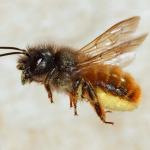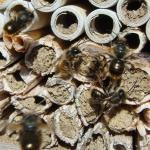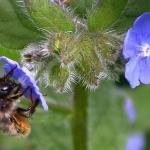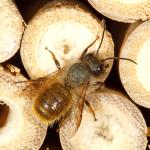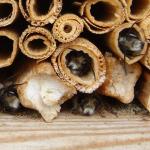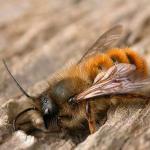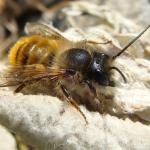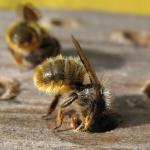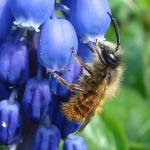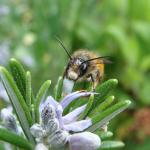Apis rufa (LINNAEUS 1758); Apis farfariseque SCOPOLI 1763; Apis agino HARRIS 1776; Apis strenuus HARRIS 1776; Apis hemisphaerica SCHRANK 1781; Apis frontalis VILLIERS 1789; Apis rufipes CHRIST 1791; Apis pusilla CHRIST 1791; Osmia hedera SMITH 1844; Apis globosa SCOPOLI 1763; Apis cornigera ROSSI 1790; Apis fronticornis PANZER 1799; Osmia fracticornis PÉREZ 1895;
Previously Osmia rufa (Panzer,1806). This species has gained a notorious reputation from the females' habit of excavating their nesting burrows and cells in crumbling or soft mortar joints, thereby, in time, undermining and possibly weakening the fabric of masonry. The bee also utilises existing holes. It is colloquially known as the red mortar bee or red mason bee.
Widely distributed throughout much of Britain as far north as Perthshire. A common species, except in parts of northern England and in Scotland. A recent arrival in Ireland. There are a few old records from the Channel Islands. The species is found throughout much of the Palaearctic, the range extending from Sweden and Denmark, south to Spain and Morocco, and east to Japan.
This bee is not regarded as being scarce or threatened.
A relatively easy species to identify, particularly the female.
For notes on identification see here.
Virtually ubiquitous in lowland Britain. Often common in gardens and parks in large cities
Univoltine; April (or occasionally late March) to June, or sometimes July.
Females of this bee nest in a variety of existing cavities, from burrows in the soil and dead wood, the space beneath roof tiles, deep fissures in soft or crumbling mortar joints, to more unusual situations, such as the inside of door locks. Soft mortar or soil may also be excavated by the bee. The cell walls are built from mud, brought to the nest site as pellets held in the bee's mandibles and tamped into position with the pair of conspicuous prong-like extensions on the clypeus. Osmia bicornis is one of only two British Osmia species which utilise mud for their nests, all the others using leaf pulp. The winter is passed as fully-formed bees within tough, reddish-brown silken cocoons. A nest containing provisioned cells is illustrated by Westrich (1989). Nesting habits and life-history are described by Raw (1972), Westrich (1989) and O'Toole & Raw (1991).
In addition to the flowers visited for their pollen, the bee visits many species for nectar, including fruit blossom, such as raspberry (Rubus idaeus), plum (Prunus domestica), pear (Pyrus sp.) and apple (Malus sp.).
Nests of this species are invaded by the following hymenopterous cleptoparasites and parasitoids: Chrysis ignita (Chrysididae), Sapyga quinquepunctata (Sapygidae), Stelis phaeoptera (Apidae), Monodontomerus dentipes and M. obscurus (Torymidae). Inquilines belonging to other orders are the fly Cacoxenus indigator (Drosophilidae), the beetle Megatoma undata (Dermestidae) and the mites Chaetodactylus osmiae (Chaetodactylidae) and Tyrophagus species (Acaridae).
Profile written: 1998
Proofed: January 2012


